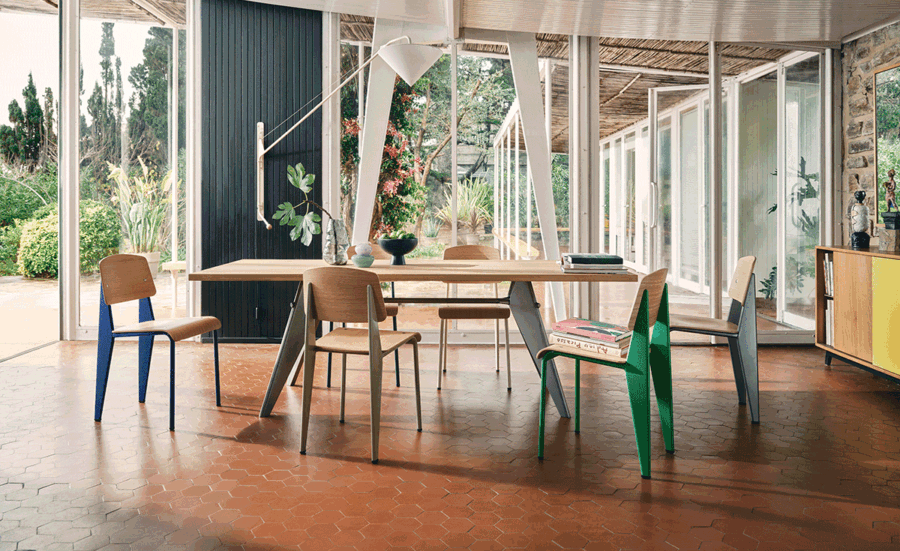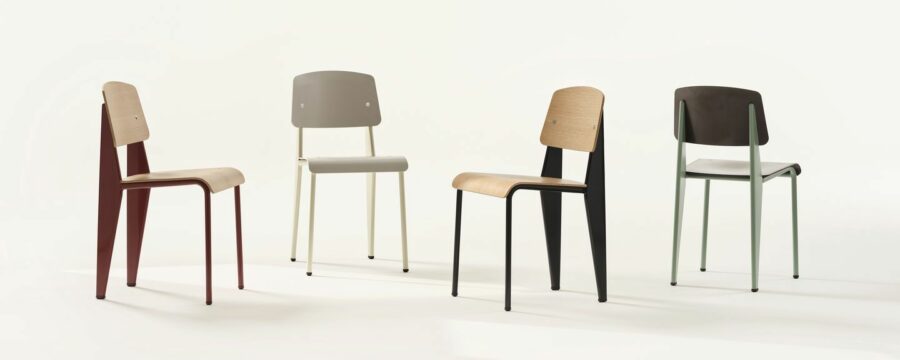Vitra & Cube Gallery: The Standard Chair – When Structure Determines Design
The French designer, architect and engineer Jean Prouvé created the Standard Chair in 1934. This design exemplifies a fundamental aspect of Prouvé’s numerous furniture designs and architectural works: his unwavering focus on structural requirements.
The load on the back legs of a chair, where it supports the weight of the sitter’s upper body, is greater than on the front legs. This is hardly a surprising discovery, but no other seating design demonstrates this principle as clearly as the Standard Chair: while tubular steel suffices for the front legs, which bear a relatively light load, the back legs are made of voluminous hollow sections that transfer the primary stress to the floor. The profile of the back legs, formed from thin bent sheet steel, resembles an aircraft wing, with the widest measurement at the point where the leg meets the seat frame – that is, where the stress is greatest. The tapered shape of the hollow section from the seat surface upwards simultaneously defines the angle and position of the backrest.
The 1934 model was introduced as Chair No. 4, since it had been preceded by three prototypes; further versions continued to be developed under the name ‘Standard’. Up until the early 2000s, the work of Jean Prouvé was known outside of France to just a small circle of architects and collectors. Although re-editions of his furniture existed, his designs did not find the attention and distribution they deserve.
Why does a company like Vitra, who is committed to contemporary design, also produce furniture that was conceived long ago? The answer: because some designs from the past remain unsurpassed and have lost none of their vitality or relevance. Notable examples include the work of Charles and Ray Eames, Alvar Aalto, Ludwig Mies van der Rohe, Marcel Breuer – and likewise Jean Prouvé.
“For me, Jean Prouvé was the French counterpart to Charles and Ray Eames. What they have in common is the combination of structural honesty and an ensuing creative expression of timeless beauty.” – Rolf Fehlbaum, Chairman Emeritus, Vitra
New colours for the Standard
Vitra is expanding the palette for Jean Prouvé’s furniture to include some of the original Prouvé colours. The existing options of deep black, Japanese red and Blanc Colombe will be joined by Gris Vermeer, Bleu Dynastie, Blé Vert and Bleu Marcoule, as well as the Métal Brut variant in unpainted steel.
Metal & Wood
The Standard was manufactured in Jean Prouvé’s own factory. Most models had a metal frame and legs, with a seat and backrest made of wood. Other variations were made completely of metal or – especially during wartime and the related metal shortages – entirely of wood. Some had cushions in various materials, or demountable components for ease of transport; the last models with back legs made of aluminum followed in the 1950s.
Metal & Plastic
Standard SP (Siège en Plastique) builds a bridge from past to present, giving this iconic chair a contemporary look without altering its form: made of robust plastic, the seat surface and backrest of Standard SP come in a palette of finely modulated colours.
The Jean Prouvé Collection at the Vitra Design Museum
The Vitra Design Museum in Weil am Rhein, Germany, is home to the world’s most extensive Jean Prouvé museum collection. It dates back to the 1980s when Rolf Fehlbaum (Chairman Emeritus at Vitra) acquired the first Jean Prouvé design, an Antony chair that he found in Paris, sparking Fehlbaum’s interest in the work of Jean Prouvé.
Find the latest from Vitra now available locally at The Cube Gallery.
You might also like...
-
Pierre Cronje: Quoin Rock Wine Estate

Gracefully positioned on the slopes of the Simonsberg Mountains in Stellenbosch, Quoin Rock Wine Estate offers guests a stellar combination of jaw-dropping Winelands views, gourmet ...
-
How to add a touch of lush greenery to your home with Studio Delta.

Still going strong, biophilic design has turned from a trend to a lifestyle, with designers and homeowners embracing all that nature has to offer, from ...
-
SHF shares the ultimate guide accent chair

Armchairs, ottomans, slipper chairs and tub chairs – when it comes to statement seating, there’s so much to choose from. To help, here furniture retailer ...
-
Bitalian: Italian Luxury Furniture Mastery

Step into a realm of unmatched sophistication and artisanship, curated from Italy’s most esteemed brands. As South Africa’s exclusive distributor of Rugiano, Natuzzi Italia, Natuzzi ...





























